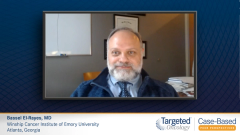
Future Directions and Unmet Needs for Gastric Carcinoma
Episodes in this series
Bassel El-Rayes, MD:I would like to conclude by discussing the future directions and unmet needs in gastric cancer. Of course, there are a number of unmet needs in this disease. The therapy that we have has impacted survival of our patients, but unfortunately, the majority of patients with stage IV disease eventually progress and become refractory to all available therapies.
Therefore, we need more effective systemic therapies. One area of active research in the disease includes the role of immune therapy. Recently we’ve seen data suggesting immune therapy used with chemotherapy combinations may be beneficial in the frontline setting, specifically with nivolumab. Whether this approach will open the door for other immunomodulatory approaches in the frontline or second-line setting is still an area of active research.
In addition, it is important as we approach gastric cancer that we realize that it is not 1 disease but many diseases. Therefore, we must incorporate in our management plan a clear approach to select patients based on their molecular profile and recognize that we now have 3 biomarkers—MSI [microsatellite instability], HER2/neu, and the CPS [combined positive score], which is based on PD-L1expression. This biomarker profile keeps expanding and allows us to better select patients for therapies they would benefit from in the frontline, second-line, and third-line settings.
Thank you.
Transcript edited for clarity.
Case: A 66-Year Old Male With HER2+ Gastric Cancer
Initial presentation
- A 66-year-old man complains of a 4-month history of decreased appetite and diffuse abdominal pain
- PMH: DM, medically controlled; colonoscopy at age 55 was unremarkable; no personal or family history of cancer
- PE: bloating; abdominal pain on deep palpation; otherwise unremarkable
Clinical Workup
- Labs: Hb 9.5 g/dL, plt 104 x 109/L; other lab values WNL
- Endoscopy with biopsy: showed well differentiated papillary adenocarcinoma with invasion into the lamina propria
- EUS: irregular borders on extraluminal surfaces with hyperechogenic spots
- Abdominal/pelvic CT confirmed a 5.1 cm lesion with indistinct margins in the antrum of the stomach
- Stage IV gastric adenocarcinoma; ECOG 1
- IHC score for HER2 expression 3+
- Biomarker testing: PD-L1 0%, NTRK -
- MSI by PCR/MMR by IHC: stable
Treatment
- He was started on FOLFOX + trastuzumab
- Well tolerated for 5 cycles
- Imaging showed 3 new small pulmonary lesions
- Treatment changed to docetaxel + ramucirumab
- Treatment was well tolerated for 4 cycles when he developed neutropenia
- Patient was started on trastuzumab deruxtecan; repeat HER2 expression score was not indicated










































